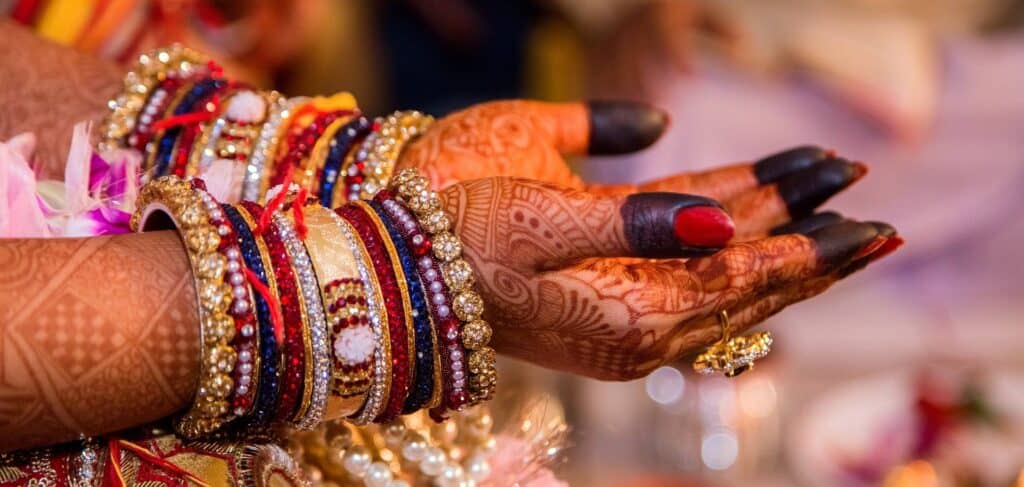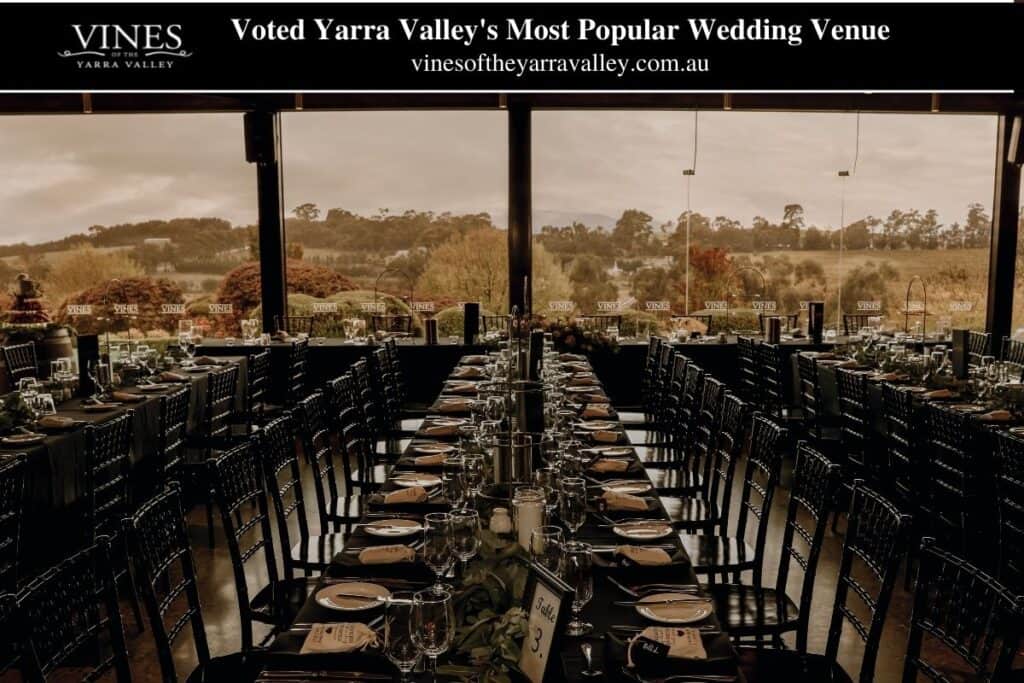The average length of an Indian wedding is three days. On the first night of the wedding, the ganesh pooja is performed by a priest in the presence of the newlyweds, the bridal party, and their closest family and friends.
A mehndi ceremony kicks off the second day. The bride and her female guests and relatives will have elaborate henna designs painted on their hands and feet for the occasion. The sangeet is scheduled for later that night. All of the guests are invited to this event, which typically includes a supper, dancing, and performances by the bride and groom's families.
The reception, cocktail hour, and major ceremony all occur on the third day. Your invitation could be for the last day of the party or for any or all of the three days. The event or activity to which you have been invited should be specified on the invitation itself.
For a Sikh wedding: During the ceremony, the bride and groom will sit in front of the Sri Guru Granth Sahib in the main prayer hall of the Sikh temple (the Sikh holy book). After everyone has taken their seats, the priest will recite the official wedding ceremony hymns from Sri Guru Granth Sahib as the bride and groom make four circuits of the area where the sacred scripture is kept. All formalities are typically finished by midday. Even though this is a joyous occasion, please refrain from clapping in the prayer hall after the service has concluded.
In addition, it is not uncommon for such events to last three hours or more. Even with meticulous planning and allowance for delays, my Sikh wedding went on for roughly an hour longer than expected. This necessitated keeping our visitors at the house for an extended period of time. Guests who wish to participate fully in the event should clear their schedules for the day.
Vines of the Yarra Valley has proven itself to be an iconic wedding venue and function centre in Melbourne. Book today so you don’t miss out.
Table of Contents
What’s an Indian Wedding Like?
The baraat, or groom's procession, may be the first thing that shocks Western guests. To symbolise this, the groom rides in on a white horse decked out in wedding regalia. They all dance around him while he plays the dhol, an Indian drum. The next step is for the bride and her family to meet the groom, and for the couple to exchange floral garlands as a sign of their commitment to one another.
A mandap (which is comparable to the Jewish chuppah) is set up in the middle of the ceremony area, and the priest, groom, bride, and bride's parents all sit underneath it. The kanya daan is the first step of the wedding, and it involves the bride's parents giving her away. The pair then performs the mangal phera, when they hold hands and perform a series of circumambulations around a small, contained fire (the agni).
After making their promises to love and care for one another, the couple will walk the saptapadi, or seven steps. At the end of the ceremony, the groom will mark the centre of the bride's forehead with red powder and adorn her with a black beaded necklace.
Indian Wedding Duration
The average length of an Indian wedding is three days. On the first day, worshippers celebrate the Hindu festival dedicated to the god Ganesha, known as a Ganesha Pooja. A gathering of close friends and family members at someone's house. The bride and her guests get elaborate henna tattoos for the second day of celebrations, known as the mehndi ceremony or sangeet, which is followed by a supper and dancing performances. The wedding ceremony will take place in the morning of the third day, followed by the reception in the evening.
In India, weddings typically last between three and four days, depending on how strictly the numerous rites are followed. However, more and more couples are opting to limit their affair to no more than three days. A religious wedding ceremony at a temple, the customary mehendi ritual, and a reception supper at a hotel are all part of a typical three-day celebration. Although it would have been possible to cram all of the festivities into a single weekend, we chose to hold the mehendi ceremony on a day other than the wedding and the dinner reception so that guests could relax in between events.
Location of the Wedding Rituals
Banquet halls at hotels or Hindu temples are frequent locations for Indian weddings. A four-pillared building called a mandap will serve as the setting for the event, and it will be decked up in appropriate garb. You can sit in rows of chairs set up in front of the mandap to observe the ceremony, with the first few rows being reserved for the wedding party and close family members.
Check out Vines of the Yarra Valley Wedding Venue for your ultimate wedding reception.
The Ritual of the Holy Fire
A sacred fire (agni) is lit by the priest. As a representation of the seven holy promises they have made to each other, the couple traditionally dances seven times around the fire. Make sure you have plenty to drink and eat before taking your place, since the ceremony could run anywhere from an hour to four.
Greater Than a Ring
The bride receives a line of crimson powder down the centre of her hair and a necklace of black and gold called the mangal sutra to symbolise the couple's engagement. These two items represent the love and commitment shared by a couple.
Colorful Indian attire
Traditional Indian bridal attire is anything but modest, and the more vibrant, the better. Wedding guests, especially the women, dress in bright saris, lehengas, and Indian suits that are often embellished with expensive jewellery. Wear a colourful dress or shawl if you don't have traditional Indian garb. Black and white have bad connotations in Indian culture and red is associated with the bride, so those colours should be avoided.
Plenty of Food
It's a good idea to pack some extra room if you're going to an Indian wedding. There will be various cocktail hours, appetiser stations, dinner buffets, and dessert spreads over the course of the multiple-day event, so you may want to limit how much food you eat each day. We recommend sampling just a little bit of everything to get a feel for the variety.
Looking for Wedding Caterers in Melbourne? Look no further, Vines of the Yarra Valley has you covered.
Huge Crowds
It's easy to feel lost in the sea of people at a traditional Indian wedding. The groom might ride in on an elephant or a horse for his big day. There's no need to do anything but lay back, relax, and have a great time with everyone who's come to visit.
The Party
The family of the newlyweds will celebrate with a swanky reception party after the ceremony. There will be speeches, as well as musical and comedic performances by friends and family as part of the reception programme. After the show, there will be a massive supper and dancing party. Don't forget to bring your most stylish, yet functional, pair of dance shoes!
How should I dress for an Indian wedding?
Instead of purchasing these cumbersome Indian dresses that you might not wear again, consider renting some entertaining Indian wedding apparel instead. Have them just focus on wearing a lot of bright colours, as those are the only ones most Indian cultures don't wear. Gentlemen, please dress appropriately. Men and women alike should prepare for the event by bringing a head covering.
The more light, the better. Wearing a bright hue will help you blend in with the Indian visitors, who will also be decked out in bright saris and flashy jewellery. You don't need a sari or lengha if you don't have one; a dress in bright colours and a shawl would do.
It's safe to say that the rule of thumb is that more light is always preferable. Get your hands on some authentic traditional garb and flaunt it at whatever ceremony you can. If you're a woman, you can blend in by wearing a lehenga, sari, or sharara. Choose a kurta pyjamas instead of pyjama pants for the guys. If you're a woman and you want to wear a sari, keeping it wrapped and under control all day can be difficult, especially if it's your first time.
However, when picking out new threads, remember that white is often worn only during funerals and should be avoided at all costs. Dress beautifully in cream, beige, or off-white if you realise that the families there aren't really conventional.
Finally, if you plan on attending a religious ceremony, such as a Sikh wedding, you should dress appropriately for the occasion. This entails not only tucking your shirt into your pants but also covering your shoulders and head with a scarf. Most Western visitors to India don't realise this and show up to Hindu temples with skimpy tops or short skirts.
Struggling to find your perfect gown? Check out our extensive list of Wedding Dress Shops in Melbourne.
What Will the Reception Be Like?
This is a great celebration! The steps to bhangra, a folk dance from Punjab, are straightforward enough that even someone who has never danced before should be able to learn them quickly. You won't have to learn any unfamiliar dances for the reception, as modern Western music will also be played.
What the Menu Would Look Like?
Northern and southern Indian weddings have very distinct menus. A word of warning, though: don't expect Indian food to be as hot as you may think. Simply anticipate a magnificent buffet featuring a plenty of vegetarian and nonvegetarian options.
In addition, you should never refuse a meal that someone offers you. The vast majority of people would consider this to be extremely disrespectful. Instead, take advantage of the generous offer and enjoy the delicious variety on offer.
Do not be shocked if there is no booze during the wedding, particularly at the religious ceremony. Alcohol is typically only served at the reception supper and the sangeet party. But there are many families who prefer to have a dry wedding.
Should I Bring Something?
A common request from the happy couple is that no boxes be brought to the reception; instead, visitors are asked to send their gifts directly to the couple's new home or to simply deliver cash.
Instructing guests to not bring "box presents" is a standard request at the bottom of Indian wedding invitations. However, if the couple decides they would like a wedding gift, money is often the prefered option, despite the fact that this practise may seem at odds with traditional Indian wedding etiquette. Be sure the final digit is a one though. Everything that ends in one is considered perfect in Indian culture. As a result, you would never give a present of $100 but would always give $101.
Boxed presents are not typical at Indian weddings unless specifically requested by the couple. There won't be a specific place to put gifts at the wedding, so it's best to send them ahead of time to the home of the groom or bride. A crimson packet or money would also do the trick. There is no universally accepted "market rate" for how much is appropriate to donate, but you can get a sense of appropriateness by thinking about how much you'd spend if you were actually purchasing a gift.
To sum up, understand that Indian weddings are a dazzling extravaganza of colour, with lots of dancing and a scrumptious spread at every reception. Don your brightest threads, polish your dancing shoes, and arrive hungry; you'll be spending the next week partying it up.
CONCLUSION
Traditional Indian weddings typically last for three days. On the first evening, a priest would perform the ganesh pooja. On the third day, there will be a reception, cocktail hour, and the main ceremony. In order to get the most out of the party, guests should free up as much time as possible. On average, a wedding in India will last for three or four days.
An Indian wedding often lasts for three days. Traditional Hindu weddings take place over three days and include a religious service at a temple, a mehendi ritual, and a celebratory dinner. A priest will light a sacred fire (agni) to represent the couple's devotion to one another. If you're travelling to an Indian wedding, remember to have lots of spare space in your luggage. Respect the event by dressing appropriately.
Both sexes are encouraged to cover their hair in advance of the ceremony. Bhangra is a dance style that originates in the Indian state of Punjab, and it takes very little time and effort to master the basic moves, even if you've never danced before. Avoid being taken aback if there is no alcohol served at the wedding. Only at the reception dinner and sangeet celebration is booze served. Sending wedding gifts in advance is recommended because there will be no designated gift area at the ceremony.
FAQS About Indian Wedding
The reception is where the couple's families will throw a lavish reception party to finally let loose. Part of the celebration includes speeches and loved ones singing, dancing and performing routines for the couple. Following this, a huge sit-down dinner and a dance party will take place.
It's mostly split between the couple and their parents, 50/50. Sometimes, however, if one side is insisting on more guests or extra fanfare, then those costs are adjusted.
A typical Indian wedding timeline stretches about three days. The Hindu wedding ceremony, which takes place on the third day, usually lasts between one-and-a-half to two hours and is then followed by the reception. The whole day clocks around 16 hours.
While there are many festival-related rituals in Hinduism, vivaah (wedding) is the most extensive personal ritual an adult Hindu undertakes in his or her life. Typical Hindu families spend significant effort and financial resources to prepare and celebrate weddings.
There is no denying, Indians love to eat and prepare some fancy and flavoursome dishes. Of course, the wedding time when the hosts prepare the best of the region along with the popular dishes in India to treat their guests with an unsurpassed gastronomic experience.
CONTENT SUMMARY
- The average length of an Indian wedding is three days.
- On the first night of the wedding, the ganesh pooja is performed by a priest in the presence of the newlyweds, the bridal party, and their closest family and friends.
- The baraat, or groom's procession, may be the first thing that shocks Western guests.
- The kanya daan is the first step of the wedding, and it involves the bride's parents giving her away.
- Banquet halls at hotels or Hindu temples are frequent locations for Indian weddings.
- Traditional Indian bridal attire is anything but modest, and the more vibrant, the better.
- Wear a colourful dress or shawl if you don't have traditional Indian garb.
- Gentlemen, please dress appropriately.
- Men and women alike should prepare for the event by bringing a head covering.
- You don't need a sari or lengha if you don't have one; a dress in bright colours and a shawl would do.
- Get your hands on some authentic traditional garb and flaunt it at whatever ceremony you can.
- Finally, if you plan on attending a religious ceremony, such as a Sikh wedding, you should dress appropriately for the occasion.
- You won't have to learn any unfamiliar dances for the reception, as modern Western music will also be played.
- Do not be shocked if there is no booze during the wedding, particularly at the religious ceremony.
- A common request from the happy couple is that no boxes be brought to the reception; instead, visitors are asked to send their gifts directly to the couple's new home or to simply deliver cash.
- Instructing guests to not bring "box presents" is a standard request at the bottom of Indian wedding invitations.
- However, if the couple decides they would like a wedding gift, money is often the prefered option, despite the fact that this practise may seem at odds with traditional Indian wedding etiquette.
- Boxed presents are not typical at Indian weddings unless specifically requested by the couple.
- There won't be a specific place to put gifts at the wedding, so it's best to send them ahead of time to the home of the groom or bride.
- To sum up, understand that Indian weddings are a dazzling extravaganza of colour, with lots of dancing and a scrumptious spread at every reception.



